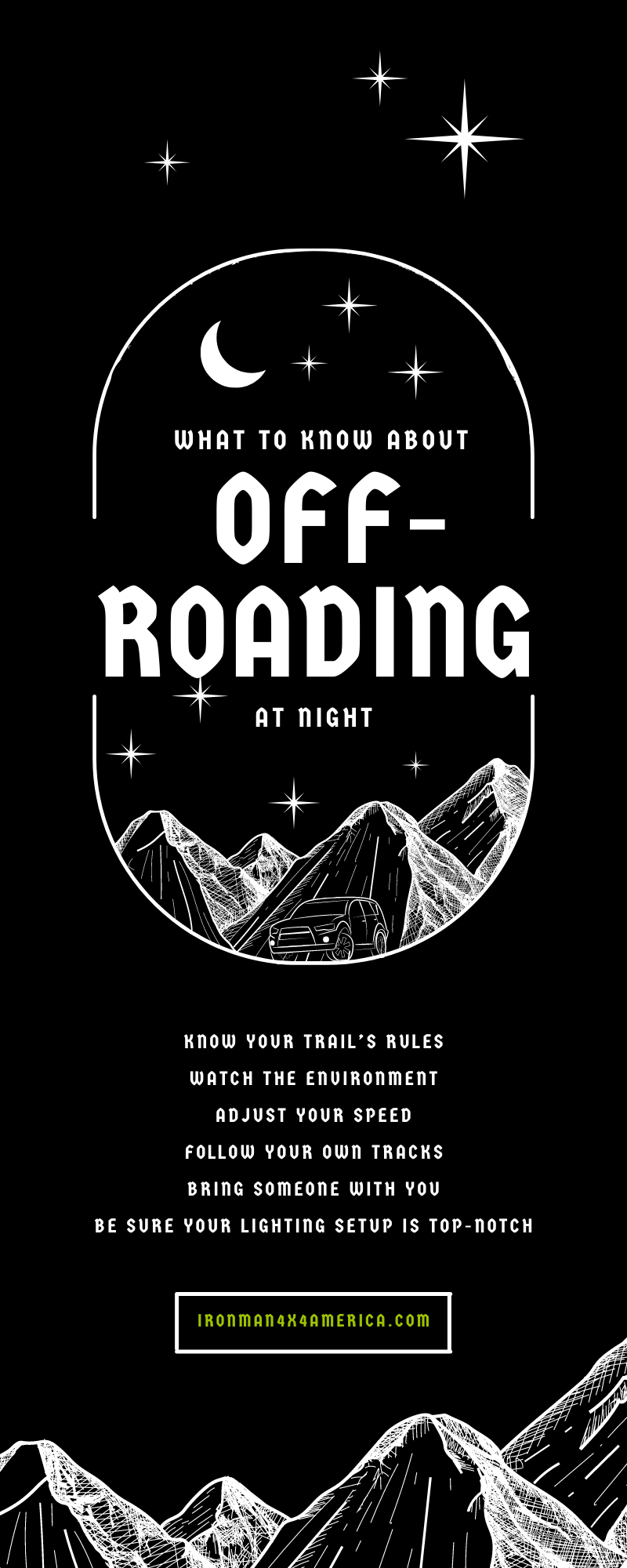What To Know About Off-Roading at Night
Most of us can relate to the experience of having a parent or behind-the-wheel instructor inundating us with the many dangers of driving at night. It was almost enough to scare some of us into following our curfews.
Most of us drive at night without giving it a second thought. However, off-roading at night presents new challenges. This is what to know about off-roading at night.
Know Your Trail’s Rules
Before you get excited about the idea of off-roading at night, you have to figure out whether or not the trip is even possible. While some trails and are totally open for night adventures, others close at dusk. This is especially true of national and off-road parks. Call ahead to make sure you’re free to hit the trails after dark.
Watch the Environment
One of the reasons it’s so challenging to drive at night is the fact that you may potentially have trouble seeing other factors in your environment—namely, other cars. But once you leave the more controlled setting of the streets, you’ll have to contend with a lot more than sleepy drivers.
Tides
If you’re off-roading on the beach and are returning on the same trail you took earlier in the day, chances are the tide is different than when you left. And in the dark, it’s difficult to see the water until you’re upon it.
When you’re driving close to the water, it’s a good idea to keep your speed low and your distance lights on to give you the best chance to see the water at a distance. You can also keep your window open to allow your sense of hearing and smell to help.
Dew
When the temperature reaches the dew point, your trail will likely become much slicker than it was during the day. This is especially true in warm, humid areas. This can make the handling on a trail much different at night than it was in the day.
Use the same principles for driving on dew-covered trails that you would on rainy trails. Drive slow, and keep your tires aired down for better traction.
Temperature
This isn’t as big of a problem in temperate regions in the summer. But if you’re driving between fall and spring or you’re driving in the desert, the temperature drop at night is not something you want to ignore if you’re going to be off the beaten trail.
Even if it’s warm during the day, make sure you bring warm clothes and blankets to stash in the car just in case you end up stranded. Also, be aware of frost setting in and making the trail even slicker or fog that makes the roads even more difficult to see.
Adjust Your Speed
We have said it before, but it’s worth repeating: take your time. Off-roading at night is not the time to turn up the speed. Obstacles are harder to pick out, conditions are slicker, and animals can potentially come out of nowhere. Even if you’ve driven a trail a hundred times, don’t try to take it at a hundred miles an hour.
Follow Your Own Tracks
This is mostly applicable if you plan on hitting the sand dunes where the nature of descents can change as the light fades. It’s difficult to retrace your steps backward in the light, let alone in the dark. The best way to avoid getting lost is to try following your own tracks.
Bring Someone With You
This is also true in the daylight, but having someone with you when you hit the trails is always a good idea. A friend can be an extra set of eyes to help you navigate obstacles or help you recover your vehicle if you end up in a jam.
This is even important at night. You’re more likely to run into animals than in the day and the temperature is colder, so you’ll want to get your car recovered faster. At the same time, it’s harder to get yourself unstuck in the dark. A buddy will help keep you from getting stuck by yourself in the middle of the woods all night.
Be Sure Your Lighting Setup Is Top-Notch
If you remember nothing else, this is one of the most important things to know about off-roading at night: get a good lighting setup. A good light setup is more than having the brightest bulbs possible. It’s about having a variety of lights for a variety of patterns, such as:
- Driving lights
- Ditch lights
- Spotlights
- Fog lights
- Work Lights
- Rock Lights
- Light bars
Also, keep in mind that different lights are more suited for different terrains. For example, rock lights naturally work well if you’re rock crawling or driving through the brush, but they won’t help as much when you’re driving on the beach.
If you want to make sure you have the lights you need to get behind the wheel tonight, check out our collection of LED driving lights for sale. Soon enough, you’ll be as good at driving the trails at night as you are in the day.


